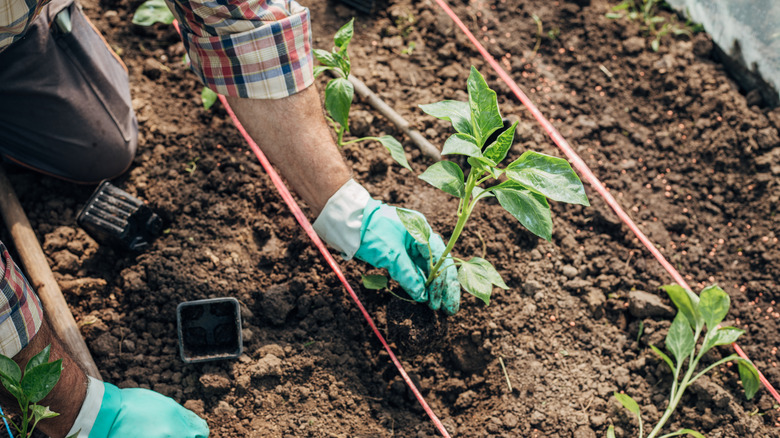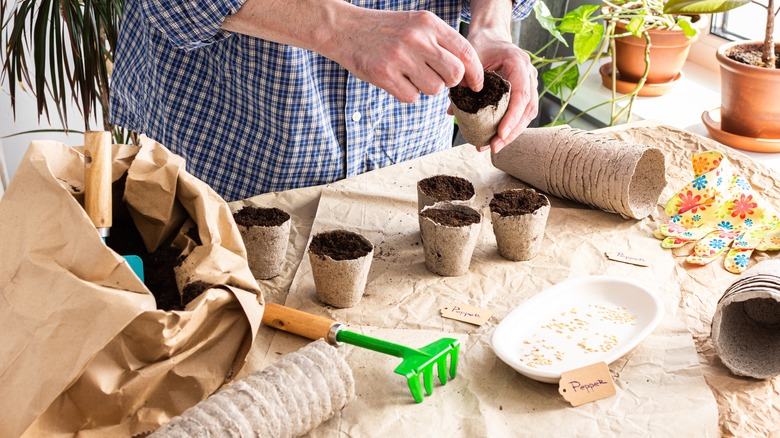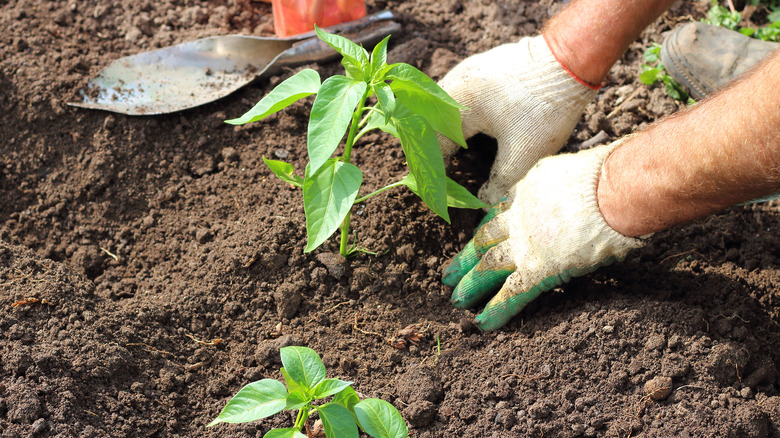The Best Time Of Year To Plant Peppers In The Garden For A Delicious Harvest
Whether sweet or spicy, there are a myriad of ways vegetable lovers delve into the delicious world of peppers (Capsicum annuum). Yet, somehow, what truly elevates the experience of eating one of these veggies is knowing you're relishing your homegrown flavorful harvest. But growing peppers is more complicated than you think, as you need to get the planting timing right. While the general notion is to plant peppers early on during spring (or toward the end of winter), the last frost date determines the exact timing. Specifically, pepper plants can be transplanted to your garden a few weeks after the last frost. If you're starting them from seed, sow indoors around two months before the last frost.
Peppers prefer high temperatures, but unfortunately, in most USDA hardiness zones, the heat doesn't last throughout their growing season. This necessitates that they be grown indoors and transplanted into the garden when the soil becomes warm enough and the danger of frost damage is long past. Getting the planting time right becomes essential in areas with shorter warm climates. But if you can't be bothered, just get pencil-wide, under 1 foot-long, robust transplants from a nursery and plant them in your vegetable lot. Ensure they've got four to six leaves, aren't diseased or spotty, and bear no buds or flowers. However, buying the transplants instead of starting them from seed could limit the amount of cultivars you get to choose from, not to mention that they will also likely be more expensive.
When to sow pepper seeds indoors
As warm-season vegetables, pepper plants struggle to grow in cold conditions. Because of this, get a head start by sowing the seeds indoors where they can stay warm. Moreover, this minimizes the risk of the tiny seeds washing out during routine irrigation. Most cultivars are best sown around eight to 10 weeks before the last frost date. If desired, you can sow them earlier to give them more time to grow before they're transplanted, but you also don't want to keep them inside for too long. The goal is to avoid stressing the plant by exposing it to temperatures below 55 degrees Fahrenheit during its germination stage.
Guesstimating the last frost is tricky since it varies significantly across the hardiness zones, and Mother Nature sometimes throws curveballs. You can get a rough estimate by typing in your zip code on Almanac or Garden.org. Gardeners in hardiness zones 10 to 13 are an exception, as their frost-free warm climate is suitable for planting peppers throughout the year. At the right time, broadcast the seeds in a potting mix, cover the container with a heat mat, and shine grow lights to raise the soil temperature to 70 degrees Fahrenheit for faster growth. They should sprout in around two weeks and be moved to pots. About six to eight weeks after sowing, acclimate the plants by placing the pots outdoors during the day in dappled shade for a few hours, increasing the duration successively.
When to plant pepper seedlings in the garden
As long as there's no risk of a sudden frost and the night temperatures exceed 55 degrees Fahrenheit (usually two to three weeks after the last frost), your peppers can be transplanted. Otherwise, you'll end up with poor fruits and a stilted plant. Layer the ground with an about 10-inch-thick mulch layer. Spread an additional black plastic cover at least a week before planting if the soil isn't warm enough. Alternatively, plant the younglings in raised beds because they're relatively warmer. Avoid growing peppers in areas where you've grown vegetables like tomatoes, eggplants, and potatoes in the past three to four years, as these are all in the same family as peppers (nightshade) and are therefore susceptible to the same diseases, which could still be in the soil.
Follow up by digging 3- to 4-inch-deep holes at every 12 to 18-inch distance (or more, based on the cultivar) and soaking them deeply. Apply a teaspoon of phosphorus-rich fertilizer to the dug areas and place the grown transplants when it's cloudy or in late evening to stop them from wilting under heat. Pack the younglings with soil, drench their roots, and create a tiny sink around them to improve water retention. Although they love the sun, don't make the common mistake when growing peppers of exposing them to temperatures upwards of 85 degrees Fahrenheit, or you'll end up with papery fruits. When necessary, cover them in shade cloth for protection against harsh sunlight.


